MARIE-LOUISE VON MOTESICZKY* (Wien 1906 - 1996 London) Stilleben mit Azalee Öl/Leinwand, 50,6 x 61 cm signiert Motesiczky Provenienz: Marie-Louise von Motesiczky Charitable Trust, Chiswick Auktionen GB, Kunsthandel Widder Wien SCHÄTZPREIS: °€ 5.000 - 8.000 Österreichische Malerin des 20. Jahrhunderts. Vertreterin des Expressionismus, zählt zur vergessenen Generation. Der Vater stammt aus dem ungarischen Adel, die Mutter aus einer jüdischen Wiener Bankiersfamilie. Sie war die Schwester des Erfinders der Radioröhre Robert Hermann von Lieben, die Großmutter Anna von Lieben war eine der ersten Patientinnen von Sigmund Freund. Ihr Bruder Karl Motesiczky, Psychoanalytiker und Widerstandkämpfer, starb 1943 in Auschwitz-Birkenau. Sie besuchte ab 1922 die private Kunstschule der tschechischen Künstlerin Carola Machotka in Den Haar. Studierte an der Städelschule in Frankfurt am Main bei Max Beckmann war ihr Mentor und Lebensfreund. Hielt große Stücke auf sie und sah sie als Nachfolgerin von Paula Modersohn-Becker Nach dem Anschluss floh sie 1938 über die Niederlande und London nach Amersham, ab 1945 lebte sie in London. Vertiefte ihre Bekanntschaft mit Oskar Kokoschka Wurde Freundin und Geliebte von Elias Canetti. Unternahm viele Reisen u.a. nach Mexiko, wo sie ihren Kindheitsfreund Wolfgang Paalen kurz vor seinem Tod traf. Erhielt späte Anerkennung 1985 durch eine Ausstellung im Londoner Goethe-Institut auf Initiative von Hilde Spiel, eine weitere Ausstellung 1994 in der Österreichischen Galerie Belvedere. Schuf ungeschönte Bildnisse ihrer Mutter, eindringliche Selbstporträts und symbolträchtige Stillleben. Einfluss des Lehrers Max Beckmann auch in der rätselhaften Auswahl und Anordnung der Gegenstände, wie Azalee, Federkiel, Teekanne und Taschenmesser, sichtbar. „Meine Sehnsucht ist es, schöne Bilder zu malen, dadurch glücklich zu werden und andere Menschen glücklich zu machen“, formulierte Marie-Louise von Motesiczky, um ihr unermüdliches, immer sehr persönlich geprägtes, künstlerisches Schaffen bis ins hohe Alter zu erklären. Die Künstlerin wurde lange nur indirekt, als im Schatten großer Männer stehend, wahrgenommen: als Schülerin Max Beckmanns, Bekannte Oskar Kokoschkas oder Geliebte Elias Canettis. Erst infolge einer äußerst erfolgreichen Einzelausstellung des Goethe Instituts in London 1985 und einer Retrospektive in der Österreichischen Galerie im Belvedere 1994 sowie einer weiteren im Wien Museum 2007 hat sie den ihr zweifellos zustehenden Platz im Kanon großer österreichischer Künstler des 20. Jahrhunderts erhalten. Ihr Œuvre, das hauptsächlich aus Stillleben, Selbstporträts und Porträts besteht und einem sich stets wandelnden, zunehmend lyrische gebrochenen Expressionismus verpflichtet ist, kann durchaus als autobiografisch gelten. Sie erhielt eine gute künstlerische Ausbildung, an Kunstschulen in Wien, Den Haag, Frankfurt am Main, Paris und Berlin. An der Frankfurter Städelschule studierte sie ab 1927 in der Meisterklasse von Max Beckmann der lebenslang ihr Freund und Mentor blieb. Sie arbeitete intensiv auf der Suche nach ihrem eigenen Stil; die Hoffnung auf künstlerische Anerkennung in der Heimat zerstob aber mit dem Anschluss 1938. Mit ihrer Mutter – der Vater war früh verstorben – floh Motesiczky zunächst in die Niederlande und anschließend nach England, wo sie bis zu ihrem Tod lebte und arbeitete. Das Stillleben mit Azalee atmet Ruhe, Charme und Liebe. Ein hübsch rot gesiegelter Brief ist zu sehen. Er liegt geöffnet und gelesen auf dem vollgestellten Sekretär. Der Absender hat auch ein Foto von einer Küstenlandschaft mitgeschickt. Neben dem Blumentopf liegt ein Klappmesser, das wohl als Brieföffner gedient haben mag. Die leuchtend rote Feder in der Mitte könnte ein Dekorationsobjekt, aber auch ein Schreibutensil sein. In ihren Stillleben zeigt Motesiczky gern ihre häusliche Umgebung; persönlichen Gegenständen weist sie eine herausgehobene Bedeutung zu. Gut möglich, dass der abgebildete Brief von Motesiczkys Geliebt
MARIE-LOUISE MOTESICZKY* (Vienna 1906 - 1996 London) Still Life with Azalea oil/canvas, 50,6 x 61 cm signed Motesiczky Provenance: Marie-Louise von Motesiczky Charitable Trust, Chiswick auctions GB, Fine Arts Widder Vienna ESTIMATE °€ 5.000 - 8.000 Austrian painter of the 20th century. Representative of Expressionism, belongs to the forgotten generation. Her father came from the Hungarian nobility, her mother from a Jewish Viennese banking family. She was the sister of the inventor of the radio tube Robert Hermann von Lieben, her grandmother Anna von Lieben was one of the first patients of Sigmund Freund. Her brother Karl Motesiczky, psychoanalyst and resistance fighter, died in Auschwitz-Birkenau in 1943. She attended the private art school of the Czech artist Carola Machotka in Den Haar from 1922. Studied at the Städelschule in Frankfurt am Main with Max Beckmann was her mentor and lifelong friend. Held high regard for her and saw her as a successor to Paula Modersohn-Becker After the Anschluss, she fled to Amersham via the Netherlands and London in 1938, and lived in London from 1945. Deepened her acquaintance with Oskar Kokoschka Became a friend and lover of Elias Canetti. Took many trips, including to Mexico, where she met her childhood friend Wolfgang Paalen shortly before his death. Received late recognition in 1985 through an exhibition at the London Goethe Institute on the initiative of Hilde Spiel, another exhibition in 1994 at the Austrian Gallery Belvedere. Created unadorned portraits of her mother, haunting self-portraits, and still lifes rich in symbolism. Influence of teacher Max Beckmann also visible in the enigmatic selection and arrangement of objects, such as azalea, quill, teapot and pocket knife. My longing is to paint beautiful pictures, to be happy through it and to make other people happy," said Marie-Louise von Motesiczky, explaining her tireless, always very personal, artistic work wich she continued into old age. For a long time, the artist was only perceived indirectly, as standing in the shadow of great men: as a student of Max Beckmann an acquaintance of Oskar Kokoschka or a lover of Elias Canetti. Only as a result of an extremely successful solo exhibition at the Goethe Institute in London in 1985 and a retrospective at the Austrian Gallery at Belvedere Vienna in 1994 and another at the Vienna City Museum in 2007 did she receive the place in the canon of great Austrian artists of the 20th century that she undoubtedly deserves. Her oeuvre, which consists mainly of still lifes, self-portraits and portraits and is committed to a constantly changing, increasingly lyrical, fractured expressionism, can definitely be considered autobiographical. She received a good artistic education at art schools in Vienna, The Hague, Frankfurt am Main, Paris and Berlin. From 1927 she studied at the Städelschule in Frankfurt in the master class of Max Beckmann who remained her lifelong friend and mentor. She worked intensively in search of her own style; the hope of artistic recognition at home, however, was interrupted with the annexation of Austria in 1938. Motesiczky fled with her mother – her father had died young – first to the Netherlands and then to England, where she lived and worked until her death. The still life with azalea breathes calm, charm and love. A nice red sealed letter can be seen. It lies open and read on the cluttered bureau. The sender also sent a photo of a coastal landscape. Next to the flowerpot is a jackknife that may have served as a letter opener. The bright red feather in the middle could be a decorative object, but also a writing utensil. In her still lifes, Motesiczky likes to show her domestic surroundings; she assigns a special meaning to personal objects. It is quite possible that the letter pictured is from Motesiczky's lover, the writer Elias Canetti, who also fled to England. In July 1943, Marie-Louise von Motesiczky wrote to Elias Canetti: "Dear, dear, dearest person, first
MARIE-LOUISE VON MOTESICZKY* (Wien 1906 - 1996 London) Stilleben mit Azalee Öl/Leinwand, 50,6 x 61 cm signiert Motesiczky Provenienz: Marie-Louise von Motesiczky Charitable Trust, Chiswick Auktionen GB, Kunsthandel Widder Wien SCHÄTZPREIS: °€ 5.000 - 8.000 Österreichische Malerin des 20. Jahrhunderts. Vertreterin des Expressionismus, zählt zur vergessenen Generation. Der Vater stammt aus dem ungarischen Adel, die Mutter aus einer jüdischen Wiener Bankiersfamilie. Sie war die Schwester des Erfinders der Radioröhre Robert Hermann von Lieben, die Großmutter Anna von Lieben war eine der ersten Patientinnen von Sigmund Freund. Ihr Bruder Karl Motesiczky, Psychoanalytiker und Widerstandkämpfer, starb 1943 in Auschwitz-Birkenau. Sie besuchte ab 1922 die private Kunstschule der tschechischen Künstlerin Carola Machotka in Den Haar. Studierte an der Städelschule in Frankfurt am Main bei Max Beckmann war ihr Mentor und Lebensfreund. Hielt große Stücke auf sie und sah sie als Nachfolgerin von Paula Modersohn-Becker Nach dem Anschluss floh sie 1938 über die Niederlande und London nach Amersham, ab 1945 lebte sie in London. Vertiefte ihre Bekanntschaft mit Oskar Kokoschka Wurde Freundin und Geliebte von Elias Canetti. Unternahm viele Reisen u.a. nach Mexiko, wo sie ihren Kindheitsfreund Wolfgang Paalen kurz vor seinem Tod traf. Erhielt späte Anerkennung 1985 durch eine Ausstellung im Londoner Goethe-Institut auf Initiative von Hilde Spiel, eine weitere Ausstellung 1994 in der Österreichischen Galerie Belvedere. Schuf ungeschönte Bildnisse ihrer Mutter, eindringliche Selbstporträts und symbolträchtige Stillleben. Einfluss des Lehrers Max Beckmann auch in der rätselhaften Auswahl und Anordnung der Gegenstände, wie Azalee, Federkiel, Teekanne und Taschenmesser, sichtbar. „Meine Sehnsucht ist es, schöne Bilder zu malen, dadurch glücklich zu werden und andere Menschen glücklich zu machen“, formulierte Marie-Louise von Motesiczky, um ihr unermüdliches, immer sehr persönlich geprägtes, künstlerisches Schaffen bis ins hohe Alter zu erklären. Die Künstlerin wurde lange nur indirekt, als im Schatten großer Männer stehend, wahrgenommen: als Schülerin Max Beckmanns, Bekannte Oskar Kokoschkas oder Geliebte Elias Canettis. Erst infolge einer äußerst erfolgreichen Einzelausstellung des Goethe Instituts in London 1985 und einer Retrospektive in der Österreichischen Galerie im Belvedere 1994 sowie einer weiteren im Wien Museum 2007 hat sie den ihr zweifellos zustehenden Platz im Kanon großer österreichischer Künstler des 20. Jahrhunderts erhalten. Ihr Œuvre, das hauptsächlich aus Stillleben, Selbstporträts und Porträts besteht und einem sich stets wandelnden, zunehmend lyrische gebrochenen Expressionismus verpflichtet ist, kann durchaus als autobiografisch gelten. Sie erhielt eine gute künstlerische Ausbildung, an Kunstschulen in Wien, Den Haag, Frankfurt am Main, Paris und Berlin. An der Frankfurter Städelschule studierte sie ab 1927 in der Meisterklasse von Max Beckmann der lebenslang ihr Freund und Mentor blieb. Sie arbeitete intensiv auf der Suche nach ihrem eigenen Stil; die Hoffnung auf künstlerische Anerkennung in der Heimat zerstob aber mit dem Anschluss 1938. Mit ihrer Mutter – der Vater war früh verstorben – floh Motesiczky zunächst in die Niederlande und anschließend nach England, wo sie bis zu ihrem Tod lebte und arbeitete. Das Stillleben mit Azalee atmet Ruhe, Charme und Liebe. Ein hübsch rot gesiegelter Brief ist zu sehen. Er liegt geöffnet und gelesen auf dem vollgestellten Sekretär. Der Absender hat auch ein Foto von einer Küstenlandschaft mitgeschickt. Neben dem Blumentopf liegt ein Klappmesser, das wohl als Brieföffner gedient haben mag. Die leuchtend rote Feder in der Mitte könnte ein Dekorationsobjekt, aber auch ein Schreibutensil sein. In ihren Stillleben zeigt Motesiczky gern ihre häusliche Umgebung; persönlichen Gegenständen weist sie eine herausgehobene Bedeutung zu. Gut möglich, dass der abgebildete Brief von Motesiczkys Geliebt
MARIE-LOUISE MOTESICZKY* (Vienna 1906 - 1996 London) Still Life with Azalea oil/canvas, 50,6 x 61 cm signed Motesiczky Provenance: Marie-Louise von Motesiczky Charitable Trust, Chiswick auctions GB, Fine Arts Widder Vienna ESTIMATE °€ 5.000 - 8.000 Austrian painter of the 20th century. Representative of Expressionism, belongs to the forgotten generation. Her father came from the Hungarian nobility, her mother from a Jewish Viennese banking family. She was the sister of the inventor of the radio tube Robert Hermann von Lieben, her grandmother Anna von Lieben was one of the first patients of Sigmund Freund. Her brother Karl Motesiczky, psychoanalyst and resistance fighter, died in Auschwitz-Birkenau in 1943. She attended the private art school of the Czech artist Carola Machotka in Den Haar from 1922. Studied at the Städelschule in Frankfurt am Main with Max Beckmann was her mentor and lifelong friend. Held high regard for her and saw her as a successor to Paula Modersohn-Becker After the Anschluss, she fled to Amersham via the Netherlands and London in 1938, and lived in London from 1945. Deepened her acquaintance with Oskar Kokoschka Became a friend and lover of Elias Canetti. Took many trips, including to Mexico, where she met her childhood friend Wolfgang Paalen shortly before his death. Received late recognition in 1985 through an exhibition at the London Goethe Institute on the initiative of Hilde Spiel, another exhibition in 1994 at the Austrian Gallery Belvedere. Created unadorned portraits of her mother, haunting self-portraits, and still lifes rich in symbolism. Influence of teacher Max Beckmann also visible in the enigmatic selection and arrangement of objects, such as azalea, quill, teapot and pocket knife. My longing is to paint beautiful pictures, to be happy through it and to make other people happy," said Marie-Louise von Motesiczky, explaining her tireless, always very personal, artistic work wich she continued into old age. For a long time, the artist was only perceived indirectly, as standing in the shadow of great men: as a student of Max Beckmann an acquaintance of Oskar Kokoschka or a lover of Elias Canetti. Only as a result of an extremely successful solo exhibition at the Goethe Institute in London in 1985 and a retrospective at the Austrian Gallery at Belvedere Vienna in 1994 and another at the Vienna City Museum in 2007 did she receive the place in the canon of great Austrian artists of the 20th century that she undoubtedly deserves. Her oeuvre, which consists mainly of still lifes, self-portraits and portraits and is committed to a constantly changing, increasingly lyrical, fractured expressionism, can definitely be considered autobiographical. She received a good artistic education at art schools in Vienna, The Hague, Frankfurt am Main, Paris and Berlin. From 1927 she studied at the Städelschule in Frankfurt in the master class of Max Beckmann who remained her lifelong friend and mentor. She worked intensively in search of her own style; the hope of artistic recognition at home, however, was interrupted with the annexation of Austria in 1938. Motesiczky fled with her mother – her father had died young – first to the Netherlands and then to England, where she lived and worked until her death. The still life with azalea breathes calm, charm and love. A nice red sealed letter can be seen. It lies open and read on the cluttered bureau. The sender also sent a photo of a coastal landscape. Next to the flowerpot is a jackknife that may have served as a letter opener. The bright red feather in the middle could be a decorative object, but also a writing utensil. In her still lifes, Motesiczky likes to show her domestic surroundings; she assigns a special meaning to personal objects. It is quite possible that the letter pictured is from Motesiczky's lover, the writer Elias Canetti, who also fled to England. In July 1943, Marie-Louise von Motesiczky wrote to Elias Canetti: "Dear, dear, dearest person, first
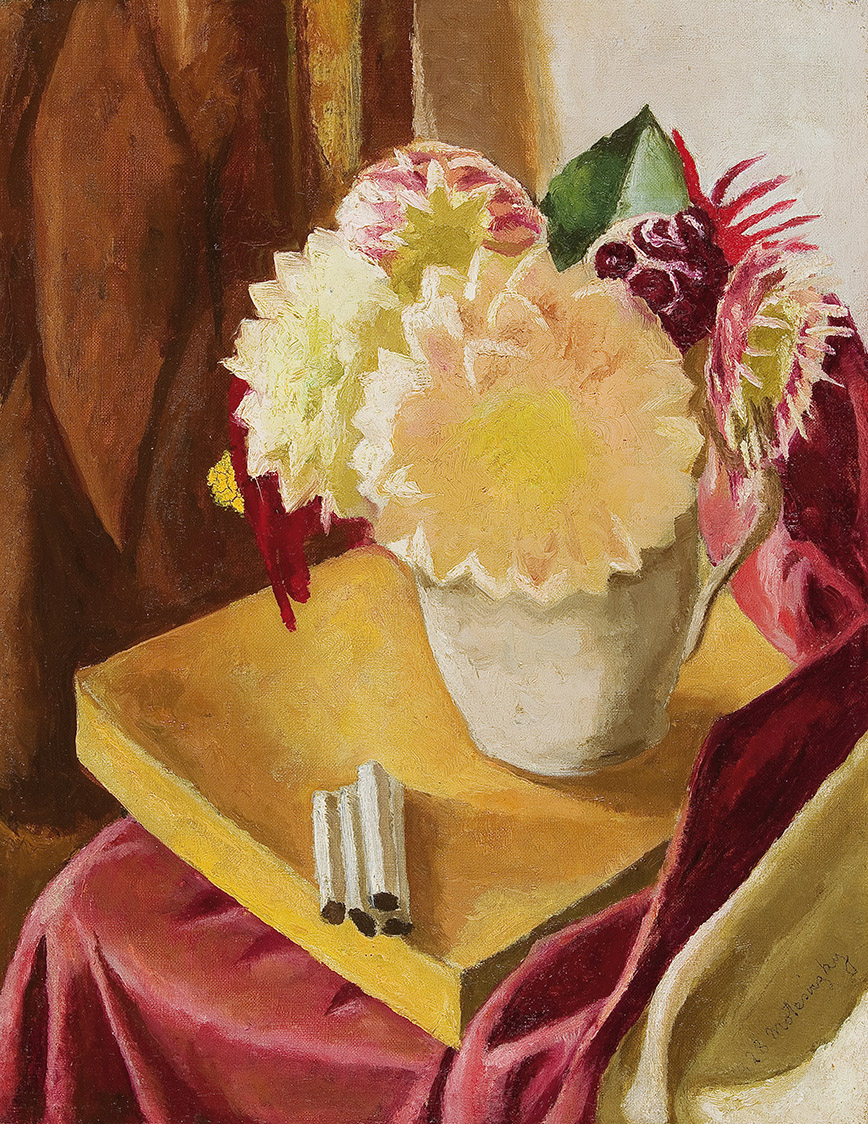




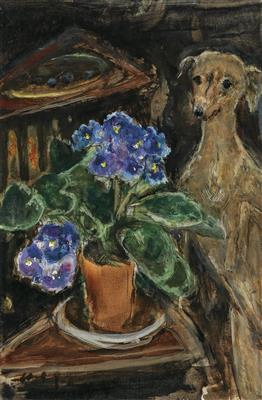



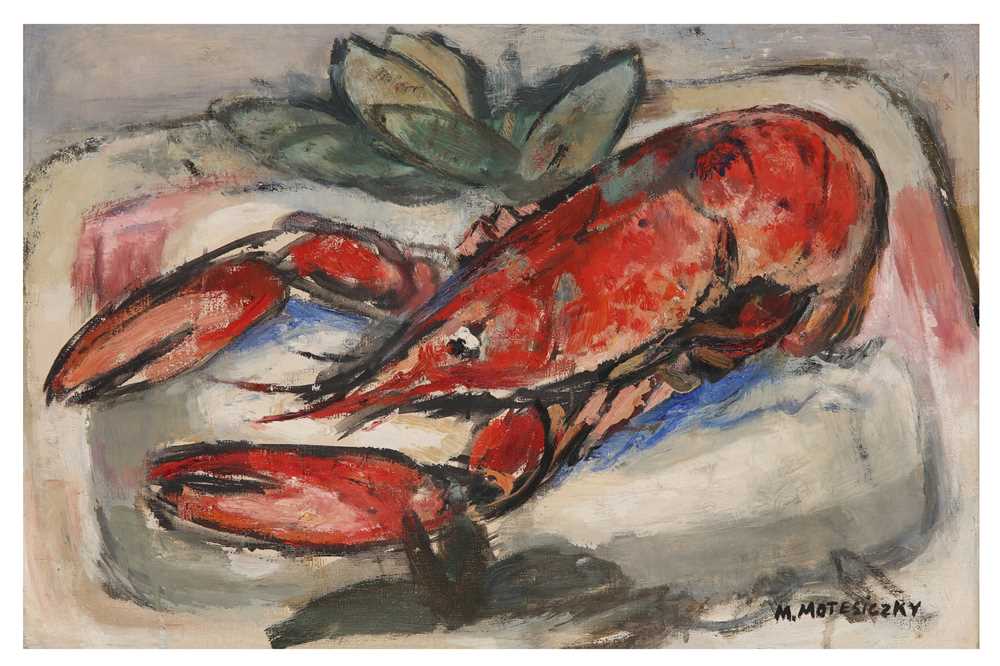

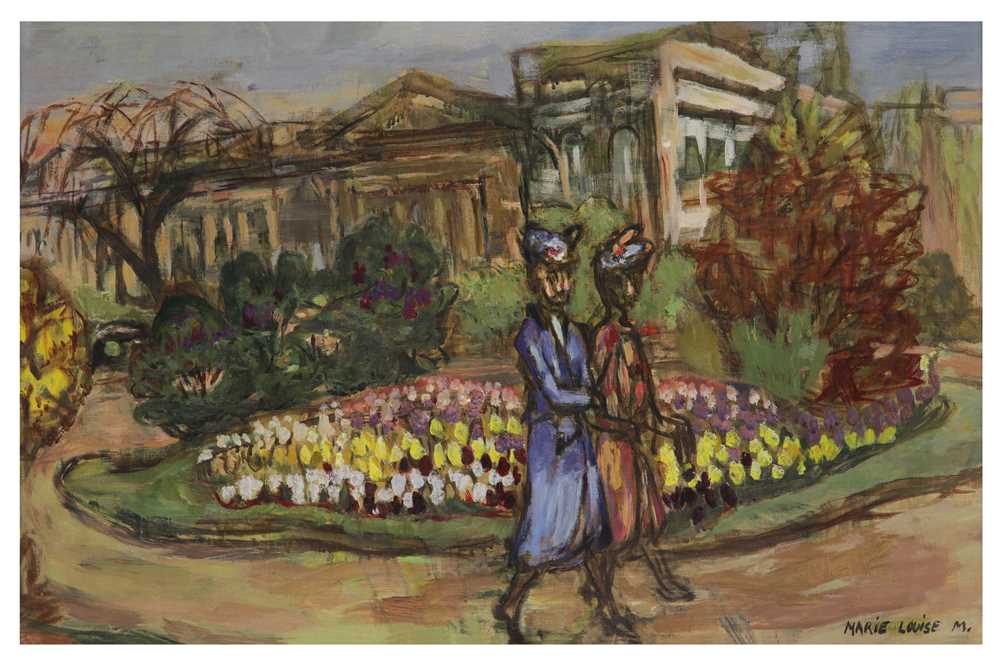

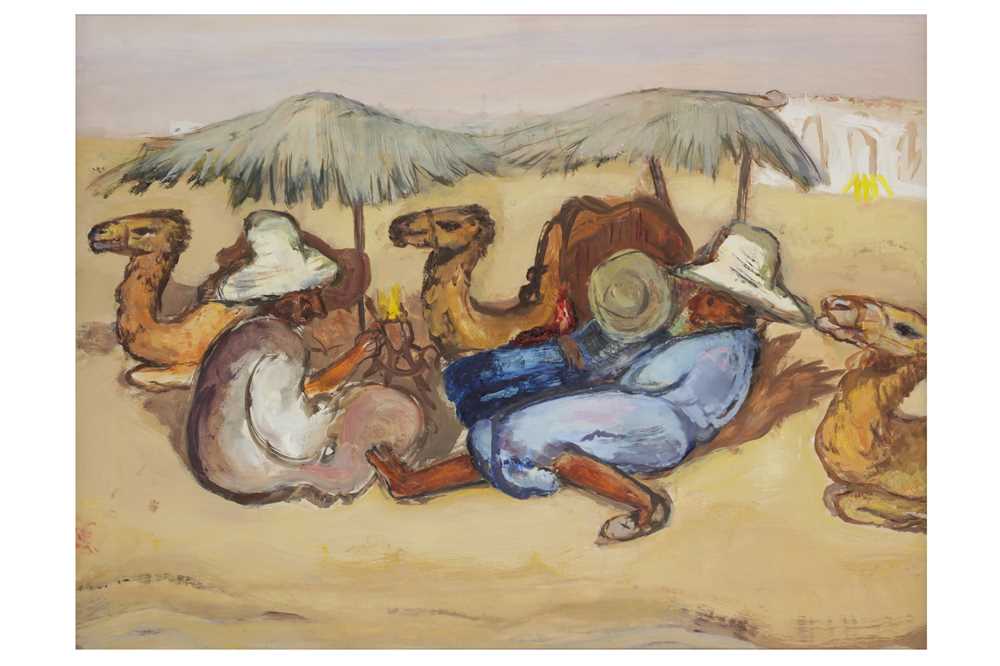
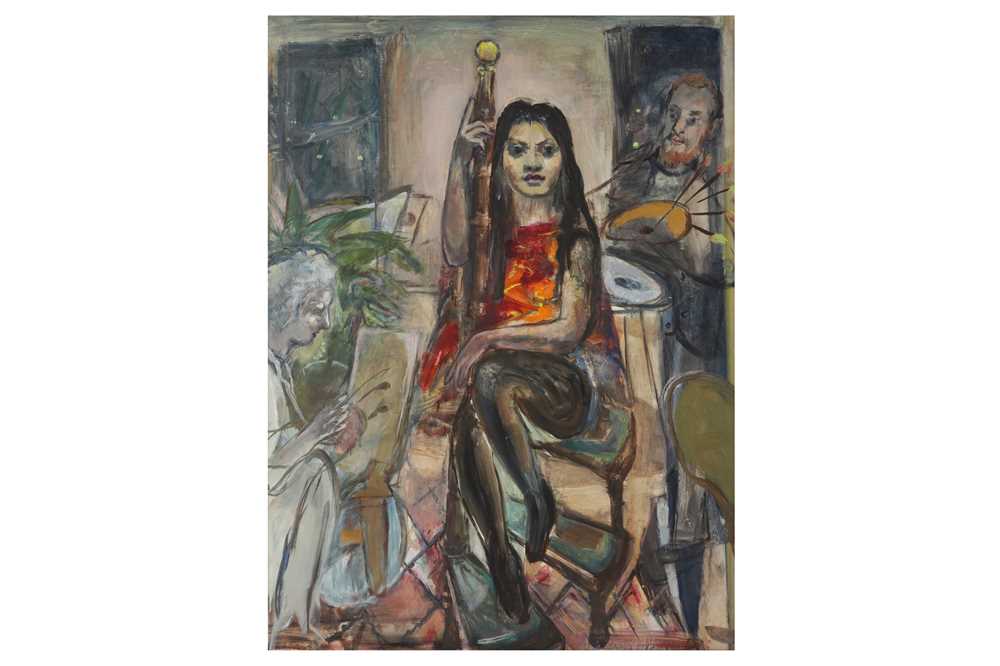
Testen Sie LotSearch und seine Premium-Features 7 Tage - ohne Kosten!
Lassen Sie sich automatisch über neue Objekte in kommenden Auktionen benachrichtigen.
Suchauftrag anlegen